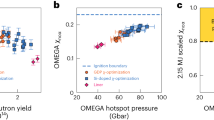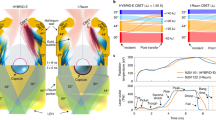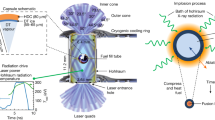Abstract
Irradiating a small capsule containing deuterium and tritium fuel directly with intense laser light causes it to implode, which creates a plasma hot enough to initiate fusion reactions between the fuel nuclei. Here we report on such laser direct-drive experiments and observe that the fusion reactions produce more energy than the amount of energy in the central so-called hot-spot plasma. This condition is identified as having a hot-spot fuel gain greater than unity. A hot-spot fuel gain of around four was previously accomplished at the National Ignition Facility in indirect-drive inertial confinement fusion experiments where the capsule is irradiated by X-rays. In that case, up to 1.9 MJ of laser energy was used, but in contrast, our experiments on the OMEGA laser system require as little as 28 kJ. As the hot-spot fuel gain is predicted to grow with laser energy and target size, our work establishes the direct-drive approach to inertial fusion as a promising path towards burning and ignited plasmas in the laboratory. Additionally, we report a record (direct-drive) fusion yield of 0.9 kJ on OMEGA, which we achieved with thin-ice deuterium–tritium liner targets.
This is a preview of subscription content, access via your institution
Access options
Access Nature and 54 other Nature Portfolio journals
Get Nature+, our best-value online-access subscription
$29.99 / 30 days
cancel any time
Subscribe to this journal
Receive 12 print issues and online access
$209.00 per year
only $17.42 per issue
Buy this article
- Purchase on Springer Link
- Instant access to full article PDF
Prices may be subject to local taxes which are calculated during checkout





Similar content being viewed by others
Data availability
Raw data were generated at the Laboratory for Laser Energetics and are not available to the general public. Derived data supporting the findings of this study are available from the corresponding authors upon request.
Code availability
The simulation codes used in this paper are not available to the general public.
References
Nuckolls, J., Wood, L., Thiessen, A. & Zimmerman, G. Laser compression of matter to super-high densities: thermonuclear (CTR) applications. Nature 239, 139–142 (1972).
Betti, R. & Hurricane, O. Inertial-confinement fusion with lasers. Nat. Phys. 12, 435–448 (2016).
Atzeni, S. & Meyer-Ter-Vehn, J. The Physics of Inertial Fusion: Beam Plasma Interaction, Hydrodynamics, Hot Dense Matter (Clarendon Press, 2004).
Craxton, R. S. et al. Direct-drive inertial confinement fusion: a review. Phys. Plasmas 22, 110501 (2015).
Lindl, J. Development of the indirect-drive approach to inertial confinement fusion and the target physics basis for ignition and gain. Phys. Plasmas 2, 3933–4024 (1995).
Rayleigh, J. W. S. B. Scientific Papers: 1881–1887, vol. 2 (Univ. Press, 1900).
Brouillette, M. The Richtmyer–Meshkov instability. Annu. Rev. Fluid Mech. 34, 445–468 (2002).
Gopalaswamy, V. et al. Tripled yield in direct-drive laser fusion through statistical modelling. Nature 565, 581–586 (2019).
Lees, A. et al. Experimentally inferred fusion yield dependencies of OMEGA inertial confinement fusion implosions. Phys. Rev. Lett. 127, 105001 (2021).
Lees, A. et al. Understanding the fusion yield dependencies in OMEGA DT-layered implosion experiments using a physics-based statistical mapping model. Phys. Plasmas 30, 012709 (2023).
Christopherson, A. R. et al. A comprehensive alpha-heating model for inertial confinement fusion. Phys. Plasmas 25, 012703 (2018).
Christopherson, A., Betti, R. & Lindl, J. Thermonuclear ignition and the onset of propagating burn in inertial fusion implosions. Phys. Rev. E 99, 021201 (2019).
Lawson, J. D. Some criteria for a power producing thermonuclear reactor. Proc. Phys. Soc. B 70, 6–10 (1957).
Betti, R. et al. Thermonuclear ignition in inertial confinement fusion and comparison with magnetic confinement. Phys. Plasmas 17, 058102 (2010).
Zhou, C. & Betti, R. A measurable Lawson criterion and hydro-equivalent curves for inertial confinement fusion. Phys. Plasmas 15, 102707 (2008).
Bose, A., Woo, K., Nora, R. & Betti, R. Hydrodynamic scaling of the deceleration-phase Rayleigh–Taylor instability. Phys. Plasmas 22, 072702 (2015).
Goncharov, V. N. et al. Improving the hot-spot pressure and demonstrating ignition hydrodynamic equivalence in cryogenic deuterium–tritium implosions on OMEGA. Phys. Plasmas 21, 056315 (2014).
Delettrez, J., Epstein, R., Richardson, M. C., Jaanimagi, P. A. & Henke, B. L. Effect of laser illumination nonuniformity on the analysis of time-resolved x-ray measurements in UV spherical transport experiments. Phys. Rev. A 36, 3926–3934 (1987).
Hurricane, O. et al. Fuel gain exceeding unity in an inertially confined fusion implosion. Nature 506, 343–348 (2014).
Zylstra, A. et al. Burning plasma achieved in inertial fusion. Nature 601, 542–548 (2022).
Kritcher, A. L. et al. Design of an inertial fusion experiment exceeding the Lawson criterion for ignition. Phys. Rev. E 106, 025201 (2022).
Zylstra, A. B. et al. Experimental achievement and signatures of ignition at the National Ignition Facility. Phys. Rev. E 106, 025202 (2022).
Gopalaswamy, V. et al. Demonstration of a hydrodynamically equivalent burning plasma in direct-drive inertial confinement fusion. Nature Physics. https://doi.org/10.1038/s41567-023-02361-4 (2024).
Frenje, J. A. Nuclear diagnostics for inertial confinement fusion (ICF) plasmas. Plasma Phys. Control. Fusion 62, 023001 (2020).
Cerjan, C., Springer, P. T. & Sepke, S. M. Integrated diagnostic analysis of inertial confinement fusion capsule performance. Phys. Plasmas 20, 056319 (2013).
Zylstra, A. B., Nora, R., Patel, P. & Hurricane, O. Model validation for inferred hot-spot conditions in National Ignition Facility experiments. Phys. Plasmas 28, 122703 (2021).
Williams, C. A., Betti, R., Gopalaswamy, V. & Lees, A. High yields in direct-drive inertial confinement fusion using thin-ice DT liner targets. Phys. Plasmas 28, 122708 (2021).
Stoeckl, C. et al. Neutron temporal diagnostic for high-yield deuterium–tritium cryogenic implosions on OMEGA. Rev. Sci. Instrum. 87, 053501 (2016).
Theobald, W. et al. The single-line-of-sight, time-resolved x-ray imager diagnostic on OMEGA. Rev. Sci. Instrum. 89, 10G117 (2018).
Moore, A. S. et al. Neutron time of flight (nToF) detectors for inertial fusion experiments. Rev. Sci. Instrum. 94, 061102 (2023).
Churnetski, K. et al. Three-dimensional hot-spot x-ray emission tomography from cryogenic deuterium–tritium direct-drive implosions on OMEGA. Rev. Sci. Instrum. 93, 093530 (2022).
Mannion, O. M. et al. Mitigation of mode-one asymmetry in laser-direct-drive inertial confinement fusion implosions. Phys. Plasmas 28, 042701 (2021).
Igumenshchev, I. V. et al. Crossed-beam energy transfer in implosion experiments on OMEGA. Phys. Plasmas 17, 122708 (2010).
Baltazar, J. et al. Diagnosing low-mode (l < 6) and mid-mode (6 ≤ l≤ 60) asymmetries in the post-stagnation phase of laser-direct-drive deuterium–tritium cryogenic implosions on OMEGA. Rev. Sci. Instrum. 93, 123513 (2022).
Kruer, W. The Physics of Laser Plasma Interactions (CRC Press, 2019).
Seka, W. et al. Two-plasmon-decay instability in direct-drive inertial confinement fusion experiments. Phys. Plasmas 16, 052701 (2009).
Christopherson, A. et al. Direct measurements of DT fuel preheat from hot electrons in direct-drive inertial confinement fusion. Phys. Rev. Lett. 127, 055001 (2021).
Christopherson, A. et al. Inferences of hot electron preheat and its spatial distribution in OMEGA direct drive implosions. Phys. Plasmas 29, 122703 (2022).
Zylstra, A. et al. Record energetics for an inertial fusion implosion at NIF. Phys. Rev. Lett. 126, 025001 (2021).
Hurricane, O. A. et al. Beyond alpha-heating: driving inertially confined fusion implosions toward a burning-plasma state on the National Ignition Facility. Plasma Phys. Control. Fusion 61, 014033 (2018).
Betti, R. et al. Deceleration phase of inertial confinement fusion implosions. Phys. Plasmas 9, 2277–2286 (2002).
Woo, K. M. et al. Effects of residual kinetic energy on yield degradation and ion temperature asymmetries in inertial confinement fusion implosions. Phys. Plasmas 25, 052704 (2018).
Anderson, K. & Betti, R. Theory of laser-induced adiabat shaping in inertial fusion implosions: the decaying shock. Phys. Plasmas 10, 4448–4462 (2003).
Goncharov, V. N. et al. Improved performance of direct-drive inertial confinement fusion target designs with adiabat shaping using an intensity picket. Phys. Plasmas 10, 1906–1918 (2003).
Anderson, K. & Betti, R. Laser-induced adiabat shaping by relaxation in inertial fusion implosions. Phys. Plasmas 11, 5–8 (2004).
Knauer, J. P. et al. Improved target stability using picket pulses to increase and shape the ablator adiabat. Phys. Plasmas 12, 056306 (2005).
Betti, R. et al. Theory of laser-induced adiabat shaping in inertial fusion implosions: the relaxation method. Phys. Plasmas 12, 042703 (2005).
Regan, S. P. et al. Demonstration of fuel hot-spot pressure in excess of 50 Gbar for direct-drive, layered deuterium-tritium implosions on OMEGA. Phys. Rev. Lett. 117, 025001 (2016).
Cao, D. et al. Interpreting the electron temperature inferred from x-ray continuum emission for direct-drive inertial confinement fusion implosions on OMEGA. Phys. Plasmas 26, 082709 (2019).
Skupsky, S. et al. Improved laser beam uniformity using the angular dispersion of frequency modulated light. J. Appl. Phys. 66, 3456–3462 (1989).
Gatu Johnson, M. Charged particle diagnostics for inertial confinement fusion and high-energy-density physics experiments. Rev. Sci. Instrum. 94, 021104 (2023).
Acknowledgements
We thank P. Patel for discussions regarding the relationship between neutron and X-ray emission. This report was prepared as an account of work sponsored by an agency of the US Government. Neither the US Government nor any agency thereof, nor any of their employees, makes any warranty, express or implied, or assumes any legal liability or responsibility for the accuracy, completeness or usefulness of any information, apparatus, product or process disclosed, or represents that its use would not infringe privately owned rights. Reference herein to any specific commercial product, process or service by trade name, trademark, manufacturer or otherwise does not necessarily constitute or imply its endorsement, recommendation or favouring by the US Government or any agency thereof. The views and opinions of authors expressed herein do not necessarily state or reflect those of the US Government or any agency thereof. This work was performed at the Laboratory for Laser Energetics for the US Department of Energy National Nuclear Security Administration under grant no. DE-NA 0003856, and grants no. DE-SC0021072 and DE-SC0022132 from the Department of Energy Office of Fusion Energy Science. Funding for the targets utilized in this study was provided by General Atomics and funded through NNSA contract 89233119CNA000063.
Author information
Authors and Affiliations
Contributions
C.A.W. and R.B. conceived the study and wrote the paper. V.G., R.B., A.L. and R.E. developed predictive models used to design high-performance experiments. V.G., C.A.W., R.B., J.P.K., A.L., D.C., P.S.F., R.Ejaz., C.A.T., W.T., M.J.R., S.P.R., C.Stoeckl. and V.N.G. designed and executed experiments used in training the predictive models used for this work. V.G., C.A.W., R.B., A.L. D.P., J.P.K. and C.J.F designed and executed the high-performance experiment series. D.C., K.S.A., R.Epstein., J.C.-N., I.V.I., J.A.M., P.B.R., T.J.B.C., S.X.H., W.S. and V.N.G. contributed to the radiation–hydrodynamic simulation development used in this work. V.G., C.J.F., V.Y.G., W.T., D.H.E., S.I., M.J.R., H.M.C., M.G.J., R.D.P., J.A.F., R.C.S. and S.P.R. contributed to the development and analysis of diagnostics used in this work. D.B, C.F., M.K., R.T.J., M.J.B., J.M., B.S., D.G., C.Shuldberg., M.F. and D.R.H. were responsible for fielding the implosion targets used in this work. K.A.B., S.S. and L.J.W. were responsible for managing the OMEGA laser. M.L. and S.F.B.M. were responsible for managing the Omega facility and experimental operations. E.M.C. and C.D. were responsible for project management for the Laboratory for Laser Energetics.
Corresponding author
Ethics declarations
Competing interests
The authors declare no competing interests.
Peer review
Peer review information
Nature Physics thanks Vladimir Tikhonchuk and the other, anonymous, reviewers for their contribution to the peer review of this work.
Additional information
Publisher’s note Springer Nature remains neutral with regard to jurisdictional claims in published maps and institutional affiliations.
Extended data
Extended Data Fig. 1 SRTe x-ray Image.
Spatially resolved electron temperature (SRTe) diagnostic experimental x-ray image of shot number 102154. The photon simulated luminescence (PSL) is an analog for brightness. Fourier analysis of the hot-spot modes show that the \(\ell = 2\) mode is typically dominant in OMEGA implosions, and the inferred hot-spot volumes account for ellipticity. The majority of recent high-yield OMEGA implosions are round, with low semi-major to semi-minor axis ratios a/b. For example, shot 102154 has a/b = 1.03 ± 0.02.
Rights and permissions
Springer Nature or its licensor (e.g. a society or other partner) holds exclusive rights to this article under a publishing agreement with the author(s) or other rightsholder(s); author self-archiving of the accepted manuscript version of this article is solely governed by the terms of such publishing agreement and applicable law.
About this article
Cite this article
Williams, C.A., Betti, R., Gopalaswamy, V. et al. Demonstration of hot-spot fuel gain exceeding unity in direct-drive inertial confinement fusion implosions. Nat. Phys. (2024). https://doi.org/10.1038/s41567-023-02363-2
Received:
Accepted:
Published:
DOI: https://doi.org/10.1038/s41567-023-02363-2
This article is cited by
-
A boost for laser fusion
Nature Physics (2024)



